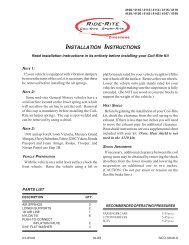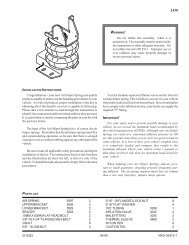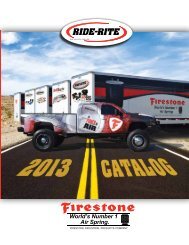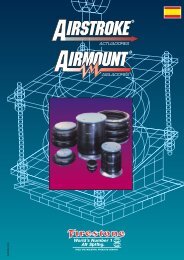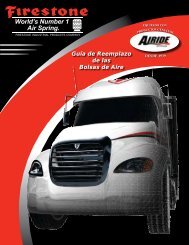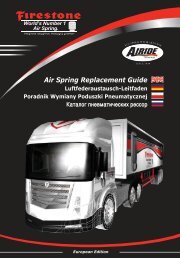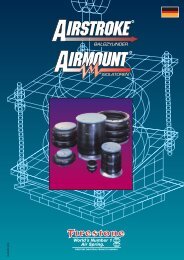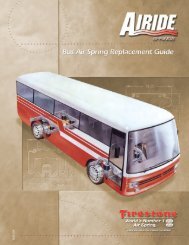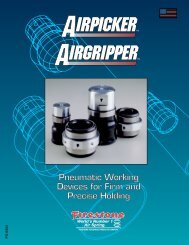G020GCA - Firestone Industrial Products
G020GCA - Firestone Industrial Products
G020GCA - Firestone Industrial Products
You also want an ePaper? Increase the reach of your titles
YUMPU automatically turns print PDFs into web optimized ePapers that Google loves.
END-EFFECTORS<br />
END-EFFECTORS<br />
performance characteristics continued<br />
Coefficient of Friction<br />
The coefficient of friction between two materials<br />
is determined with empirical data. The greater<br />
the coefficient, the more gripping force the endeffector<br />
will have. For example, the static coefficient<br />
of a rubber tire on dry asphalt is 0.71. The static<br />
coefficient of friction drops to 0.17 – 0.06 on wet,<br />
slippery roads. After the rubber begins to slip at the<br />
contact point, the static coefficient becomes the<br />
sliding coefficient of friction. The sliding coefficient<br />
is a lower value than the static. For example, the<br />
sliding coefficient of a rubber tire on dry asphalt<br />
is approximately 0.65, compared to the 0.71<br />
static coefficient.<br />
The greater the coefficient of friction, the greater<br />
the load capacity of the picker. Therefore, it is best<br />
to handle dry objects. Wet, slippery surfaces will<br />
dramatically decrease load capacity. If the object<br />
begins to slip from the picker, the frictional force will<br />
continue to decrease. Our load curves are designed<br />
with a safety factor to compensate for various<br />
materials and coefficients. All of the load curves<br />
were generated using clean, dry, steel parts and<br />
have a safety factor of three. For example, our load<br />
carrying tests with a dry steel part indicate that the<br />
P025 can handle a 60lbs (27kg) object with 40psi<br />
(2.8bar). In order to compensate for a variety of<br />
application conditions, we have published a load<br />
carrying capacity of 20lbs (9kg) with 40psi (2.8bar).<br />
If you have any questions concerning extreme load<br />
capacities for a specific application, please call<br />
<strong>Firestone</strong> <strong>Industrial</strong> <strong>Products</strong> or your local distributor<br />
for assistance.<br />
Life<br />
Several factors affect the life of AirPicker <br />
and AirGripper end-effectors: inflation pressure,<br />
temperature, the object’s shape/surface/weight,<br />
and the expansion ratio. <strong>Firestone</strong> has conducted<br />
a series of life tests to insure the quality of our<br />
products as well as to get a general idea of life<br />
expectancy. These tests do not guarantee that each<br />
application will achieve the same results in cycle life.<br />
The actual cycle life may exceed or fall short of the<br />
published figures due to changing variables.<br />
AirGripper end-effector Life<br />
In a laboratory environment, neoprene AirGripper <br />
end-effectors exceeded 1 million cycles at the<br />
maximum recommended pressure and diameter<br />
limits. Due to poor abrasion and tear resistance, the<br />
life of silicone AirGrippers end-effectors dropped<br />
to approximately 100,000+ cycles at the maximum<br />
recommended parameters.<br />
AirPicker end-effector Life<br />
Operating at the extreme pressure and diameter<br />
limits, neoprene AirPicker end-effectors<br />
approached, and in some cases exceeded,<br />
500,000 cycles. Less durable, yet high temperature<br />
tolerant, silicone AirPicker end-effectors operated<br />
approximately 100,000 cycles at the maximum<br />
recommended parameters.<br />
Expansion Ratio<br />
The life of a picker will decrease as the ratio of<br />
inflated to deflated diameter increases. This change<br />
is described as the expansion ratio. In order to<br />
maximize the life of a picker, it is recommended<br />
that pickers be used within the suggested diameter<br />
range, preferably near the midpoint.<br />
Surface Finish<br />
The surface finish of the work piece is another<br />
critical variable in affecting the life of a picker.<br />
The smoother the finish, the longer the life.<br />
Cycle Rate<br />
High cycle rate applications do not have an<br />
adverse effect on the total cycle life of a<br />
<strong>Firestone</strong> end-effector.<br />
Temperature<br />
The temperature of the work piece is crucial to the<br />
life of a picker. For temperatures exceeding 165°F<br />
(74°C), silicone elastomer is recommended. Silicone<br />
can perform at elevated temperatures, -22°F to<br />
320°F (-30°C to 160°C), but has poor abrasion<br />
resistance. However, neoprene will become brittle at<br />
elevated temperatures, making it inoperable.<br />
9



